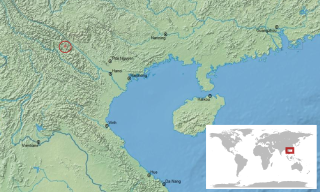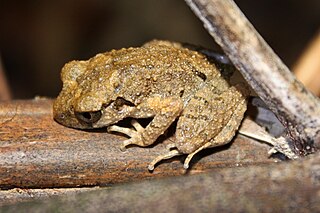
Leptolalax is a genus of frogs in the family Megophryidae. They are sometimes known as Asian toads, metacarpal-tubercled toads, or slender litter frogs, although many species-specific common names do not follow these conventions, and many species do not have common names. They are widely distributed in southeastern and eastern Asia, from southern China and northeastern India to the Malay Peninsula and Borneo. Leptolalax are typically small and have a cryptic colour pattern and no obvious morphological characters useful in systematic studies. Consequently, both molecular genetic analyses and analysis of advertisement calls by male frogs have been important in identifying new species.

Leptolalax bourreti is a frog species in the family Megophryidae. It is known with certainty only from the vicinity of its type locality in Sa Pa in northern Vietnam. Earlier records from Laos refer to Leptolalax eos and those from Thailand probably to an unnamed species. Its natural habitats are subtropical moist lowland forests, moist montane forests, and rivers. Its status is insufficiently known.

Leptobrachella liui, also known as Fujian Asian toad or Fujian metacarpal-tubercled toad, is a frog species in the family Megophryidae. Originally described from Chong'an in Fujian, it is now known to be widely distributed in southern and southeastern China from Zhejiang and Fujian west to Guizhou and Guangxi.

Leptolalax nahangensis is a frog species in the family Megophryidae. It is endemic to Tuyên Quang Province, northern Vietnam. Its natural habitats are subtropical moist lowland forests, rivers, and caves. Its status is insufficiently known. This species has only been found near the entrance to a cave in Na Hang Nature Reserve.
Leptolalax pelodytoides is a frog species in the family Megophryidae. It is known with reasonable certainty only from near its type locality, the Karen Hills region in the Kayah State, eastern Myanmar. As Leptolalax pelodytoides was one of the first megophryid species to be described from the region, later research has shown that many specimens that have been reported as L. pelodytoides represent other species, including Leptolalax bourreti, Leptolalax oshanensis, Leptolalax eos, and Leptolalax minimus. A consequence is that the most recent IUCN assessment reports much broader distribution for this species than what can be ascertained.

Leptolalax pluvialis is a frog species in the family Megophryidae. It is only known from its type locality, Fansipan mountain range in northern Vietnam, although it is expected to be found also in adjacent Yunnan, China. Its natural habitats are subtropical moist montane forests and rivers. Its status is insufficiently known.

Leptolalax sungi is a frog species in the family Megophryidae. It is found in Vĩnh Phúc and Lào Cai Provinces in northern Vietnam and in Guangxi in southern China. Its natural habitats are subtropical moist lowland forests, moist montane forests, and rivers. Its status is insufficiently known. This species was first found along a stream near Tam Đảo village, about 925 meters ASL.
Leptolalax ventripunctatus is a frog species in the family Megophryidae. It is known from Mengla County in Yunnan, southern China, from Phongsaly Province in northern Laos, and from Tam Dao in northern Vietnam. Its natural habitats are subtropical moist lowland forests and rivers. Its status is insufficiently known.
Leptolalax tamdil is an anuran amphibian belonging to the family Megophryidae. It is so far reported only from Tam Dil lake, Mizoram, India. It is a small frog, but medium-sized among Leptolalax species; the male measuring 32.3 mm, and female 31.8 mm. The species is diagnosed with unique features such as eyelids with tubercles, distinct tympanum and supratympanic folds, undilated toe tips with dermal fringes, long hind limbs, and distinct color patches.
Leptolalax khasiorum is a species of frogs belonging to the genus Leptolalax. It is so far reported only from the type locality, from the subtropical wet forests of Mawphlang in Khasi Hills, Meghalaya, India. It is a small amphibian; the male measuring 25.6 mm, and female 32.5 mm. The species is diagnosed with unique features such as eyelids with tubercles, distinct tympanum and supratympanic folds, undilated toe tips with dermal fringes, dorsum with dark blotches, flanks with large dark blotches, dark tympanic mask, limbs with dark cross-bars, and distinct color patches.
Leptolalax applebyi is a species of frog in the family Megophryidae. It is endemic to Vietnam where it is only known from near its type locality, Song Thanh Nature Reserve, Phước Sơn District in Quảng Nam Province of central Vietnam.
Leptolalax croceus is a species of toad in the family Megophryidae. Discovered in the Central Vietnam in 2010, it is endemic to the region as it is only known from its type locality, Ngoc Linh Nature Reserve in Đắk Glei District, Kon Tum Province. However, given the vicinity of the border to Laos it is also likely to be found there. Its belly has light orange color, which is unique among Leptolalax. It is a medium-sized species within its genus: snout-vent length of 16 males was in the range 22–27 mm (0.87–1.06 in). The species was found from evergreen forest at about 1,300 m (4,300 ft) elevation.
Leptolalax melicus is a frog species in the family Megophryidae. It is endemic to Cambodia where it is only known from near its type locality, Virachey National Park, Ratanakiri Province; it is expected to have a wider distribution that may reach Laos and Vietnam. Leptolalax melicus have only been found near rocky streams in evergreen forest between 650–850 m (2,130–2,790 ft) altitude.
Leptobrachella aerea is a species of frogs in the family Megophryidae. It is known from Vilabouli District, Savannakhet Province, Laos and from Hà Tĩnh, Nghệ An, Thanh Hóa, and Quảng Bình Provinces of Vietnam.
Leptolalax ardens is a species of frog in the family Megophryidae.
Leptolalax eos, also known as the Rosy Litter Frog, is a species of frog in the family Megophryidae. It is known in Bo Kluea District in northern Thailand; Phongsaly, Bolikhamxay, Oudomxai and Xaisomboun Provinces in Laos; Dien Bien, Thanh Hoa and Son La Provinces in northwestern Vietnam, and Yunnan, China. It was previously confused with Leptolalax bourreti.

Leptolalax fritinniens is a species of frog in the family Megophryidae.
Leptobrachella lateralis is a species of frog in the family Megophryidae. It was first described by John Anderson (1871), who originally named it Ixalus lateralis. The holotype is lost and its exact origins are uncertain, but it was likely collected "from some portion of the surrounding region [of Bhamò]", Myanmar. It is only known with confidence from the region of its type locality and from Nagaland in Northeast India. Its range might extend into Yunnan, China. It is sometimes called Nagaland Asian toad or Nagaland leaf litter toad.
Leptolalax laui is a species of frogs in the family Megophryidae.
Leptolalax pyrrhops is a species of frogs in the family Megophryidae.






